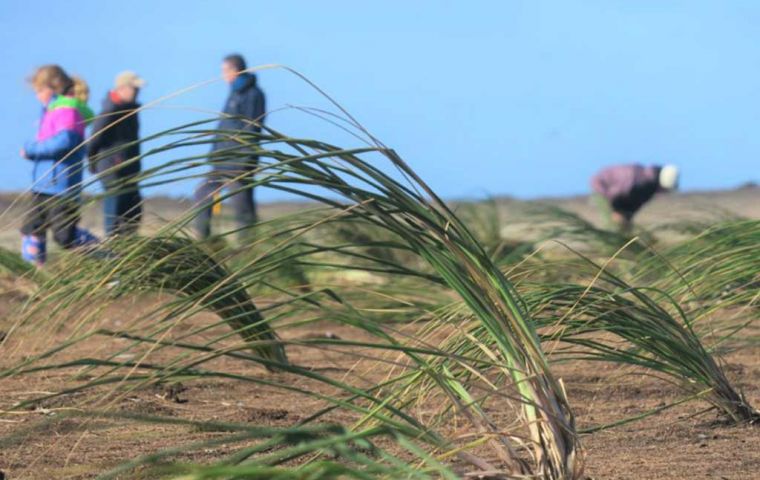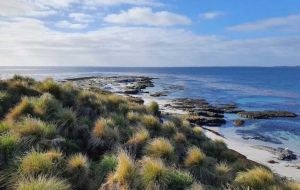MercoPress. South Atlantic News Agency
Exploring Falkland Islands' Ecosystems: Insights from the FI-BRIL Project
 Volunteers planting tussac along eroded coastlines in the Falklands (Pic Falklands Conservation)
Volunteers planting tussac along eroded coastlines in the Falklands (Pic Falklands Conservation) By Emeritus Professor Roger Flower, UCL - ”The Falkland Islands are a rather remote, treeless archipelago in the western South Atlantic. They are now probably best known for their important biodiversity, sheep farming and productive marine fisheries.
“Interest in its flora and fauna began in 1764 when the French botanist AJ Pernetty recorded local plants.
“Only later, in 1834, did the then young naturalist Charles Darwin visit the islands and was soon followed by Joseph Hooker, a botanist, in 1842.
“Since the 1800s, the Islands began to be more colonized, notably by Britain.
“Agriculture was encouraged and subsequent land-use changes began as heathland vegetation was diminished by cattle and later by sheep farming and rangeland burning.
“Notable effects included great loss of the native 2m tall tussac grass, which has become largely confined to local pockets of coastal landscapes on East and West Falkland necessitating corrective local management (Tourangean et al 2019).
“By the late 20th and early 21st Century threats to the Islands’ biodiversity and productivity were being recognized including the impacts of invasive plant species (Broughton et al 2002), soil erosion and the need for land management (Wilson et al. 1993)
“More recently climate change effects on the Ilands vegetation were recognized (Upson et al. 2016) as increasing soil moisture deficit affected plant cover.
“For wetlands of international importance, the first two Ramsar Sites were established in 2001 and 22 important bird areas (IPAs) are described (Woods, R. W. and Woods, A. 2006).
The FI-BRIL Project
“In view of the likely effects of recent environmental change threats to the Falkland Islands’ ecosystems a project was awarded to the UCL Department of Geography (Ensis) in 2000 to undertake an exploratory survey of the islands’ wetlands, lakes, ponds and streams.
“The FI-BRIL, Falkland Islands/Biodiversity Research in Lakes) Project undertook assessment of water quality and diatom microalgae, species of the latter being useful indicators of water quality, particularly pH, conductivity and nutrient levels (e.g. Bennion et al, 2003).
“In 2001, 28 sites were sampled for diatoms, water quality and other variables. The results concerning diatom species present and their relationships with water type were subsequently published (Flower, 2005, Flower et al, 2011).
“Results also included descriptions of several new diatom species and showed that their occurrences and abundances were strongly influenced by water acidity and particularly by conductivity (saltiness).
“The FI-BRIL survey provided 2001 base-line information relevant to reference conditions for the freshwater sites then sampled.
“The project also compiled supplementary information on micro-invertebrates (notably chironomids, cladocera) amphipods, site characteristics and presence of fish species in 60 sites (see McDowall et al, 2004). These data are available online or by contacting me at r.flower@ucl.ac.uk.
“The 2001 spatial survey indicated virtually pristine water quality conditions existed at all sites examined.
“Biological integrity has, however, been affected by introduced species such as brown trout (introduced in the 1940s) and local land erosion issues were noted at several sites.
“Although, without historical information (from sediment cores, water monitoring, landscape records) current trends in wetlands and aquatic ecosystem changes cannot be assessed although remote sensing techniques are becoming valuable sources of information for land use, vegetation and soil changes
“The EU Directive Water Framework Directive for Freshwaters stressed a need for both chemical and biological time-track assessments through monitoring as part of a wise management strategy for freshwaters.
“In 2020 a proposal by SAERI titled ‘Falkland wetlands and aquatic habitats: baselines for monitoring future climate change’ was successfully funded (Darwin Plus Project 116, Carter, S et al. 2022) (.pdf)).
“The project, led by Stefanie Carter, SAERI, comprised staff from the UCL Department of Geography (including Professor Julian Thompson and myself), for stream hydrology and micro-algae assessments.
“Professor Chris Evans (hydrology and water quality) and David Stroud (wetland birds and Ramsar sites) were also involved in the project. The work coincided with other SAERI programs around this time concerning climate change effects on soils, fisheries, agricultural sustainability and establishing GIS mapping.
“The 116 scoping study initiated hydrological instrumentation of two key streams and collection of data on water depths, temperatures and water quality including flora and fauna aspects.
“Over 40 pond, lake and stream sites were visited georeferenced and diatom sampling extended the original 28 sites visited in 2001, including six sites that were replicated in 2021.
“Two replicated sites had substantially altered diatom floras likely indicating considerable changes in water quality during the intervening 20 years.
“Together with developing GIS site mapping, hydrological data collection and classification of wetland types, the work collectively recommended high resolution monitoring programs for wetlands including both flowing and standing waters to help assess the pace and nature of climate change effects on these systems.
“Subsequently, a comprehensive integrated multidisciplinary and climate-environmental change assessment program for the Falklands has been proposed (Bean, 2024).
“Meteorological trends, land use practises and farmer-led land management including stocking and soil conservation as well as hydrological monitoring of freshwater bodies need to be tracked together with remote sensing of landscape variables to help build capacity and facilitate matching key drivers of climate-initiated changes.
“Clearly freshwater availability and landscape management are all imperatives for supporting productive agriculture and thriving wildlife.
“Nevertheless, disentangling the interactors and process drivers influencing the island ecosystem functions and services will be challenging.
“The findings from the FI-BRIL project and other studies highlight the importance of continued monitoring and adaptive management in order to address the evolving challenges facing the Falkland Islands’ wetlands and dryland ecosystems to help guide a sustainable future.”





Top Comments
Disclaimer & comment rulesCommenting for this story is now closed.
If you have a Facebook account, become a fan and comment on our Facebook Page!